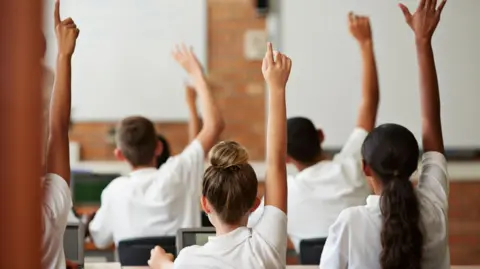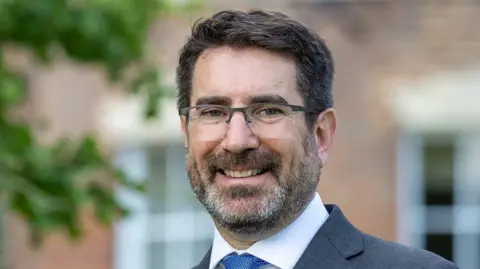Vanessa Clarke and Kate McGough
BBC News
Phil Leake
Data journalist

 Getty Images
Getty Images
The average cost of a place at a private school has increased by 22.6% in the last year – more than government estimates – after the introduction of VAT on fees, the body representing most UK independent schools says.
The Independent Schools Council (ISC) says it expects a reduction in pupils applying for private school as a result but that it is too soon to know the full effects of the policy, which was introduced mid-year.
The average termly fee for a day school in January was £7,382, which includes 20% VAT, according to the ISC. In January last year the average was £6,021.
But an HM Treasury spokesperson says the increase in fees are not only down to VAT and the data “misrepresents reality”.
VAT on private school fees was introduced on 1 January across the UK.
Chancellor Rachel Reeves said the money raised would help “provide the highest quality of support and teaching” in the state sector.
At the time, the government predicted fees would increase by about 10% as a result of the changes, saying some schools would be able to absorb part of the cost.
The ISC says that many schools were able to reduce their fees, excluding VAT, in January to “cushion the impact” on parents.
But the ISC chief executive Julie Robinson says the sector has been hit a “triple whammy” of national insurance changes, an end to charitable business rates relief and “the blow of 20% VAT on fees”.
“It seems clear to us that the government has underestimated the effect,” she said.
“We know parents have already left the sector because of the threat of VAT coming in so we do expect the reality of this to lead to further decreases but the full effects will only become apparent over the next few years,” Ms Robinson added.
The 22.6% increase in average fees compares with an 8.4% rise in 2024 and a 6.4% rise in 2023.
The figures were provided to the BBC by the ISC, which represents about 1,400 private schools across the UK. Its annual census, which looks at fees and pupil numbers, is conducted in January and is due to be released next week.
Kath decided to remove her 12-year-old son from his private school in October after she was made aware the fees would be increasing in January.
“We worked it out and it was unaffordable. Within two terms the cost was going up by 26% to almost £8,000 a term, ” she says.
Her son has special educational needs and disabilities (SEND) and she originally choose the private sector due to the small class sizes and support offered.
“We are a typical middle class family, we are not rolling in it, we have one second hand car and few holidays, we watch our money. At the very least I believe they should have brought it in at the start of the academic year.”
“Moving him mid-year was a traumatic experience but we only had 15 days to take a place once we were offered one”, she explains.
Kath has now started the process of applying for an education, health and care plan to help her son get the support he needs in his new school.
“The state system is stretched and underfunded. He is a happy and resilient boy and now we have to fight for his needs to be met.”

 Martyn Poynor
Martyn Poynor
David Morton, headmaster of The King’s School in Gloucester, which charges pupils between £3,725 and £9,050 a term, says the policy is “misjudged”.
“The government is trying to tax the more affluent areas of society in order to support the least affluent, but the wealthiest people have been affected the least.”
“It’s low to middle income families and those children on bursaries where the impact of VAT is being felt most,” Mr Morton adds.
Given overall student numbers are set to fall by 700,000 in England by 2030, the government is confident that schools in the state sector will be able to accommodate any additional pupils moving from private schools.
It estimates about 35,000 will move to the state sector in the long term and the impact will be “very small”.
Research by the think tank, the Institute of Fiscal Studies (IFS), says it would be possible for the state sector to easily accommodate extra pupils as the number leaving is bigger than the total number of children attending private schools.
The ISC says some of its members reported a 4.6% fall in Year 7 pupils in September 2024, but experts say the declining birth rate and cost of living could be having an impact.
A judicial review of the policy has been brought by three separate groups, including parents of children with SEND and low-paying faith schools. A decision is expected soon.
The court heard how the government decided to bring the policy in mid-year to maximise the amount of money it raised.
It estimates that the policy will raise an extra £460m this year, rising to £1.8bn by 2029/30.
As part of their election campaign, Labour promised this would be used to recruit 6,500 specialist teachers in England over their parliamentary term.
The state sector is struggling with recruitment and retention and unfilled vacancies are at a record high.
The government says average fees in private schools have risen over the past 25 years and pupil numbers have remained steady.
Average fees have risen by 55% in real terms since 2003, even without VAT, according to the IFS.
“Ending tax breaks for private schools will raise £1.8 billion a year by 2029-30 to help deliver 6,500 new teachers and raise school standards, supporting the 94% of children in state schools to achieve and thrive”, an HM Treasury spokesperson said.







